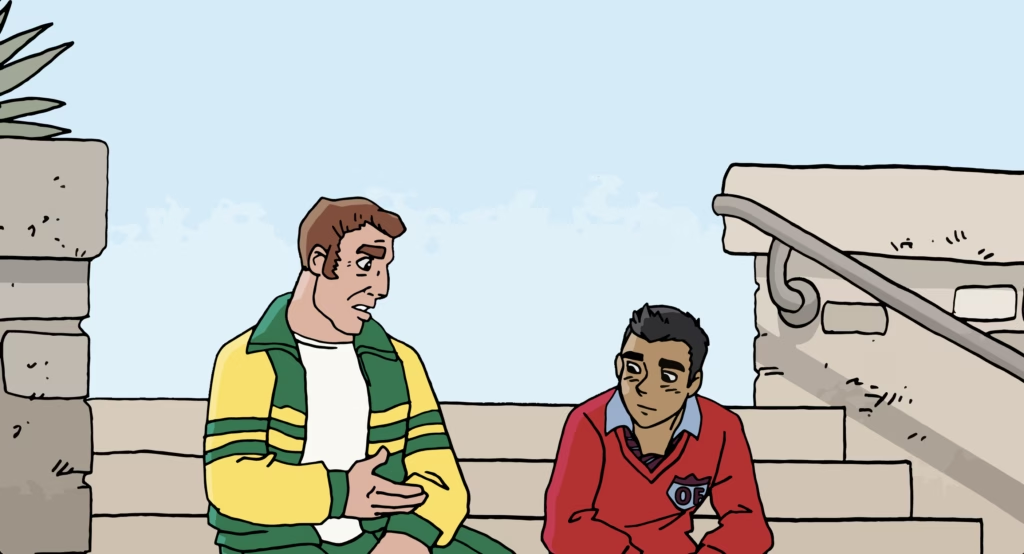Background
Adolescence is a complex developmental period, and young people can experience diverse and multi-faceted risks to health. Research has shown that for adolescents, six key modifiable health behaviours play a critical role in both physical and mental health, now and in the long term [1, 2]. These factors have been coined “The Big 6”: Dietary intake, physical activity, sleep, sedentary recreational screen time, alcohol and vape/tobacco use.
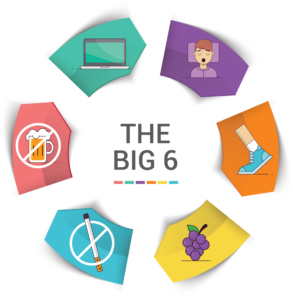
In one of the largest school-based prevention clinical trials in Australia, conducted by researchers from The Matilda Centre at The University of Sydney, significant associations were found between each of the Big 6 behaviours and depression, anxiety, and psychological distress symptoms [2]. You can read more about this here. This data stems from the rigorous evaluation of the Health4Life program, which is the first online health education program teaching year 7-8 secondary school students about the ‘Big 6’ health behaviours.
Health4Life advocates for healthy whole lifestyles, as it is important to aim for improving the Big 6 behaviours in unison, particularly as they are interrelated with each other and mental health. This is the first of a six-post blog series providing insights into each of the individual Big 6 modifiable factors for youth physical and mental health, beginning here with dietary intake.
Dietary intake and mental health
Healthy dietary intake is linked to better mental health outcomes, and this relationship can be bi-directional where poor dietary intake is associated with a greater risk of depression and anxiety. More recent research focused on youth increasingly highlights the important role a healthy, balanced diet plays in helping young people cope better with stress, manage their emotions, and get a better quality of sleep – all of which are critical for learning and brain development [1-3, 5].
More resources on the link between nutrition and mental health in youth can be found here and here.
The Australian Dietary Guidelines recommend an increase in intake of fruit and vegetables and a reduction in foods high in sugar, salt, and fat.
However, lifestyle changes and increased access to processed foods mean that most young people are not meeting these guidelines. Worryingly, less than 1% of children and young people aged 2 to 18 years consume the recommended number of vegetables each day [4,6].
The Big 6: Dietary intake
The 2023 Health4Life study analysis investigated associations between the Big 6 health behaviours and mental health among adolescents in Australia. Dietary intake was narrowed down into three areas: sugar-sweetened beverage (SSB) consumption (a leading source of added sugar in adolescents’ diets), daily fruit servings, and daily vegetable servings [2,5].
The study found that:
- Adolescents who “never/rarely” drank SSB had the lowest mental disorder symptoms, with 24% lower anxiety symptoms, 49% lower depression symptoms, and 31% lower psychological distress symptoms compared with those who drank high amounts (≥ 14 cups per week).
- Adolescents who consumed three serves (or more) of fruit daily had the lowest mental disorder symptoms, with 14% lower anxiety symptoms, 37% lower depression symptoms, and 22% lower psychological distress compared with those who consumed less than one serve of fruit daily.
- Adolescents who had two serves (or more) of vegetables daily had the lowest mental disorder symptoms, with 14% lower anxiety, 34% lower depression, and 21% lower psychological distress compared with those who consumed less than one serve of vegetables daily.
How does the Health4Life program target dietary intake?
The nutrition component of the Health4Life program is based on the Australian Dietary Guidelines, using scientifically proven multiple health behaviour change approaches such as social influence, social cognitive and self-determination theories to improve dietary intake [7]. The modules incorporate relevant information and facts into the relatable ‘peer-to-peer’ cartoon storylines. As the cartoon develops, questions and interactive activities are included to help consolidate the information students have learnt, and to empower them to apply the skills they learn in real life.
Here is an example of a multiple-choice activity (which occur throughout the cartoons):
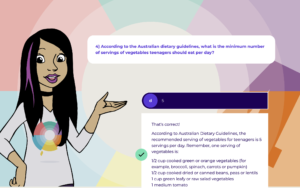
Some examples of the cartoon storyline, addressing how to read a nutritional information label correctly:
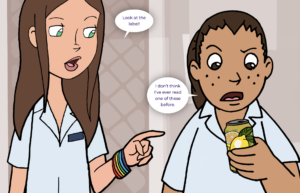
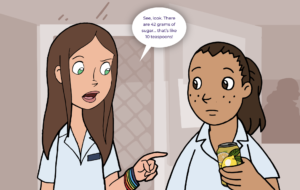
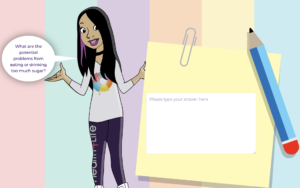
Above is an example of a “Stop and Think” activity, which occur throughout the cartoon storylines.
In addition to these activities, there are also supplementary student information sheets and worksheets (available as PDF) for each of the six lessons.
Students who have used the Health4Life program reported that it supported them to make healthy lifestyle changes. As one student said, “It actually helped me think about bad food habits I might have. I have since changed said food habits, and I feel a lot better about myself.”
Read more about the Health4Life program or register your school here.
Author: Francesca Wallis. With expert review by researchers at the Matilda Centre for Research in Mental Health and Substance Use.
References:
[1] G. Egger, “Lifestyle medicine: The ‘why’, ‘what’ and ‘how’ of a developing discipline,” Australian Journal of General Practice, vol. 48, no. 10, pp. 665–668, Oct. 2019, doi: https://doi.org/10.31128/ajgp-06-19-4955.[2] S. Smout, L. A. Gardner, N. Newton, and K. E. Champion, “Dose–response associations between modifiable lifestyle behaviours and anxiety, depression and psychological distress symptoms in early adolescence,” Australian and New Zealand Journal of Public Health, vol. 47, no. 1, p. 100010, Feb. 2023, doi: https://doi.org/10.1016/j.anzjph.2022.100010.
[3] F. N. Jacka et al., “A Prospective Study of Diet Quality and Mental Health in Adolescents,” PLoS ONE, vol. 6, no. 9, p. e24805, Sep. 2011, doi: https://doi.org/10.1371/journal.pone.0024805.
[4] Australian Bureau of Statistics (ABS). (2017). Australian Health Survey: Consumption of Food Groups from the Australian Dietary Guidelines, 2011-12. Canberra: ABS. Retrieved from https://www.abs.gov.au/
[5] A. Keller and S. Bucher Della Torre, “Sugar-Sweetened Beverages and Obesity among Children and Adolescents: a Review of Systematic Literature Reviews,” Childhood Obesity, vol. 11, no. 4, pp. 338–346, Aug. 2015, doi: https://doi.org/10.1089/chi.2014.0117.
[6] Be You, “Nutrition and mental health,” Beyou.edu.au, 2017. https://beyou.edu.au/resources/fact-sheets/wellbeing-and-stress-management/nutrition-and-mental-health
[7] Teesson M, Champion KE, Newton NC, et al, “Study protocol of the Health4Life initiative: a cluster randomised controlled trial of an eHealth school-based program targeting multiple lifestyle risk behaviours among young Australians.” BMJ Open 2020;10:e035662. doi: 10.1136/bmjopen-2019-035662






